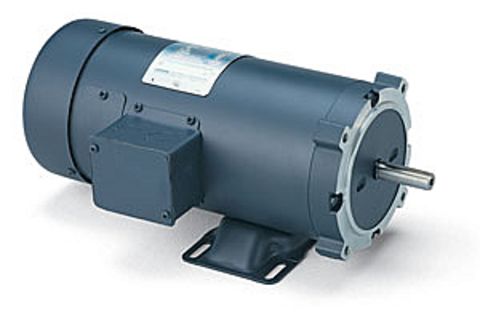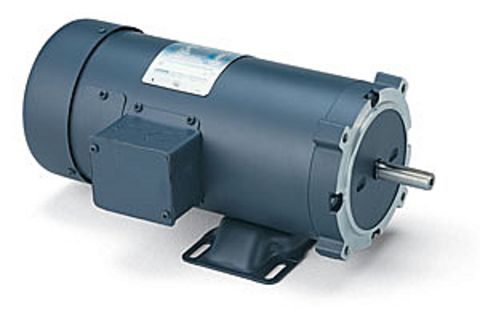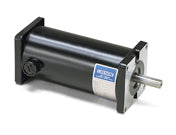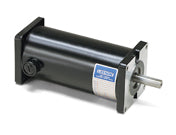316 Products
DC Motors
The common uses of Direct Current Motors are in industrial applications where reversing capabilities, a constant torque throughout the speed range, and adjustability of motor speed are critical. Examples include medical equipment, pumps, reeling tools, conveyors, textile machinery, and sports paraphernalia.
Square One Electric offers major brands of DC Motors, including Leeson, Baldor, and Worldwide Electric. Our selection ranges from 12V and 24V to larger, industrial machines.
Each motor ships brand new from the factory and comes with a manufacturer’s warranty.
Use our MASTER PRODUCT SEARCH to narrow your selection by horsepower, RPM, frame, voltage, application and more.
Need Encoders, Tachometer Kits, and other electric parts and accessories? Contact Us for a quote
How DC Motors Work
In simple terms, direct current motors convert electrical energy into mechanical energy. The rotating part of a DC motor is called a rotor and is connected to a shaft that turns in response to an applied voltage.
Read Our Blog: AC DC Electric Motor Troubleshooting
DC Motors Mechanism
A DC motor comprises an armature (or rotor) and a field magnet (or stator).
The armature contains windings woven around a core material and carries an electric current. This electrical energy is converted into mechanical energy as it travels through these windings attached to a shaft.
When an external magnetic field is applied to the motor’s stator, the magnetic poles cause currents within the armature coil(s), turning them into electromagnets. Consequently, this turns their internal magnetic fields around.
Now, both motor parts are electromagnets that work together so that when one moves toward its north pole, the other will move toward its south pole. They create a rotation from alternating directions as they move back and forth.
Replacing a DC Motor
Motor size and horsepower are related, but not all motors within a given size will produce equal horsepower. Although there are several different ways of expressing a motor’s output, as with car engines, it is more useful and intuitive to compare motors on an actual output basis.
As defined by SAE (Society of Automotive Engineers), horsepower measures a motor’s ability to move a specific mass over a distance. Torque measures its ability to produce work at a given speed.
Both torque and horsepower ratings for Direct Current Motors are commonly expressed in scientific units of lb-ft or N-m. In engineering units, however, horsepower is typically expressed in hp.
FOR ON-SITE TROUBLESHOOTING OF YOUR DC MOTORS
Types of DC Motors
The following four types of DC Motors are used in industrial settings, depending on the application requirements.
Series Wound DC Motors
In these machines, the field is wound with a few turns of larger wire and connected in series to provide varying voltage. This design offers maximum speed and high starting torque, which are in direct relation. That is, as speed increases, torque decreases, and vice versa.
Series motors are ideal for applications that start under a heavy load, such as residential or commercial sewing machines and vacuum cleaners, industrial cranes, winches, traction systems, and air compressors.
Shunt Wound DC Motors
For this type, the field is wound with many turns of small copper wires and connected in parallel with the armature winding to provide a constant current. These motors are used wherever stable speed is required because they turn at an almost constant speed (when voltage is fixed) and can deliver escalating torque by increasing motor current. Rotation may also be reversed by inverting the connections.
Starting torque is less with shunt-wound motors than with series motors, but speed is not affected by changes in load. These motors are common in many industrial applications, such as extruders, conveyors, lathes, centrifugal pumps, lifts, fans, and printing or textile equipment.
Compound Wound DC Motors
As the name suggests, this type combines series and shunt designs. Most fields are wound in shunt design while the series turns are connected in sequence with the armature.
The result is a DC machine with a starting torque between shunt and series. Also, the speed will change with the load, depending on the amount of field space allowed in the series winding.
Compound motor applications vary and include conveyors, mixers, shears, machine tools, presses, and agitators.
Permanent Magnet DC Motors
This motor type uses a permanent magnet rather than an electromagnet to maximize commutator, brush, and inertia for optimum performance. These motors are common in small DC motor applications and industrial and commercial general purposes, washdown, metric, traction, and explosion-proof applications.
PMDC Motors can simplify drive systems by effectively eliminating the need for speed reduction devices. As they are synchronous motors that don’t need a rotor slip, PMDCs do not require speed sensors to deliver accurate levels of high speed. This feature is essential for frequency converter supply.
Use our MASTER PRODUCT SEARCH to narrow your selection by horsepower, RPM, frame, voltage, application and more.
DC Motor Applications
The most common DC motors are used for residential electric appliances like fans, blenders, or hair dryers. Typically, these small appliances use AC induction motors.
However, any application which requires inverters, such as converting direct current power from a battery into alternating current, requires DC motors.
DC motors are preferred in industries where a) motor speed adjustment, b) constant torque throughout the speed range, and c) reversing capabilities are desired. These include pumps, treadmills, industrial fans, conveyors, textile machinery, turntables, and reeling systems.
DC motors’ rectangular, squirrel cage-style design allows for mounting in any direction because the rotation of conductor windings determines motor direction.
Explosion Proof DC Motors
Explosion Proof DC Motors are designed for hazardous environments with flammable gases, vapors, and combustible dust, like found in gas plants, chemical facilities, refining plants, paint areas, flour and feed mills. The motors are constructed to withstand an internal explosion of vapors or gases and contain the flame or explosion inside the motor. Common applications include conveyors, mixers, feeders, and pumps.
Our selection of XP DC motors includes Permanent Magnet and Shunt Wound machines. Both types are UL and CSA approved for Division 1, Class I – Group D and Class II – Groups F and G, with a 1.0 Service Factor. Most models include a thermostat on the field winding.
CAUTION: Misapplied motors in hazardous environments can cause a fire or explosion resulting in destruction of property, injury, or death. Only the end user or a qualified underwriter is to identify and select the proper class, group, division, and temperature code motor to meet the requirements of each installation.
Washdown DC Motors
Shop our Washdown DC Motors, designed to last in applications with routine and high pressure washings or wet environments. Ideal for food, beverage, and pharmaceutical applications.
DC Washdown Motors come in a variety of finishes to meet application requirements: stainless steel, painted, and paintless. Stainless Steel DC Motors are constructed completely in stainless, including the housing, conduit box and cover, base, fan cover, and endplates. Painted, white epoxy, and paintless units feature stainless shafts, neoprene gaskets, drain plugs, and double sealed bearings.
SQUARE ONE PROVIDES REPAIRS AND REPLACEMENTS OF DC MOTORS. Read Our Blog: AC DC Electric Motor Troubleshooting
OUR SERVICE AREA COVERS THE ENTIRE STATE OF DELAWARE AND THE SURROUNDING PARTS OF MARYLAND, PENNSYLVANIA, AND NEW JERSEY.
What is the Difference Between Brushed and Brushless DC Motors?
The traditional brushed DC machine is a simple motor that consists of an armature, a commutator, an axle, and a field magnet. Two currents are supplied:
- One goes through the stator windings to provide the magnetic field.
- The other runs through the armature windings and interacts with the magnetic field to generate motion.
On the other hand, a brushless motor uses a permanent magnet as its external rotor, with three phases of driving coils and a sensor to track rotor position. The sensor communicates its position to a controller, which activates the coils.
Brushed motors are expensive but easy to maintain. They are also equipped with simple controllers, which are not needed for fixed speed.
Brushless motors operate effectively at all speeds, have higher efficiency and smaller frames, and produce a higher speed range.
What are the Differences Between DC and AC Electric Motors?
If you’re debating whether to buy a DC motor or opt for an AC motor, these features will help you decide:
- DC motors have a higher starting torque than AC motors, which is critical in certain applications. Those that require constant low-speed or variable-speed torque are ideal for DC.
- DC motors have a speed-torque curve that’s more linear than AC motors. The torque equation is the curve plotted between motor torque and speed and explains the relation between rotation speed and generated torque.
- DC motors provide better speed control with heavy load systems, which can otherwise overload an AC machine. For this reason, DC motors are often found in rolling and paper mills where a consistent low-speed torque is needed for quality production.
- Generally, DC motors are easier to install and maintain than AC motors. Replacing a DC system with AC requires rewiring and some amount of creativity with mounting.
- DC motors can run directly off battery power or very low-voltage power sources, such as solar panels or wind turbines, without requiring any other transformers. However, since they don’t change direction by reversing polarity as AC motors do, they may need additional mechanical means to reverse their rotation direction.
Switching from DC to AC Motors
Do you currently have DC equipment in place and are considering upgrading to an AC motor and drive? Here are some things to consider:
- Budget
Your expenses would include system overhaul (wiring, physical adjustments), future maintenance, and any changes to production. All these would depend on the type of equipment you are reconditioning.
- Inventory Availability
Some items are always in stock and easier to get in a pinch than others. Many companies switch from DC to AC for this reason.
- Application
Determine whether an AC system will deliver the performance (torque and speed) required by the application. Find out as well if a new system will fit.
TAKE ADVANTAGE OF OUR DIAGNOSTIC EXPERTISE












